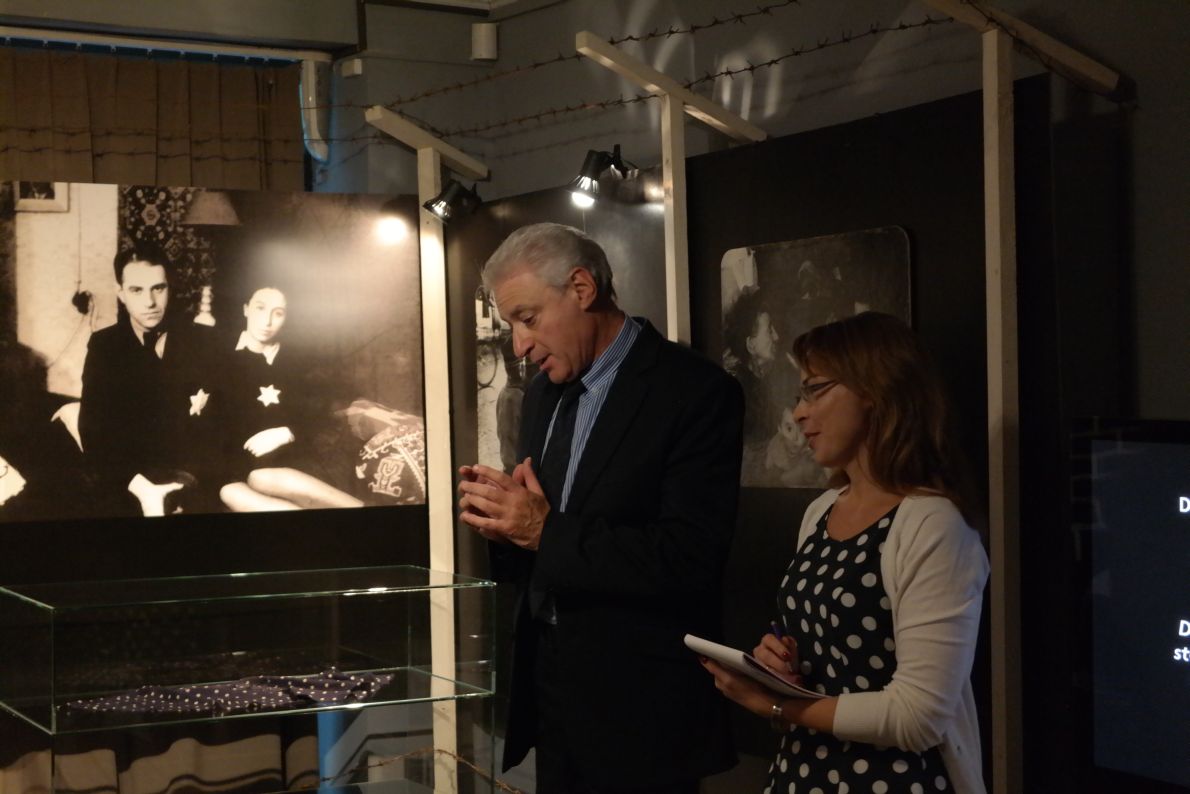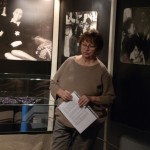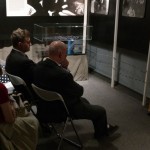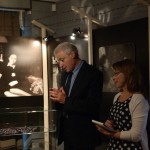The Holocaust Exhibition of the Vilna Gaon State Jewish Museum has a new exhibit. It’s a scarf. But it’s no ordinary headgear. It belonged to Dita Šperlingienė-Zupavičienė of Kaunas when she was a concentration camp victim at Stutthof and other locations.
On Thursday, September 17, 2015, the new exhibit was unveiled with much fanfare at a public event in room 7 of the museum located at Pamenkalnio street No. 12 in Vilnius. Dainius Junevičius represented the Lithuanian Foreign Ministry and director of the French Institute in Lithuania Frédéric Bellido also attended the event, which began with an introduction by Vilna Gaon State Jewish Museum deputy director Kamilė Rupekaitė and two speeches delivered in Lithuanian and translated to English.
Miša Jakobas, the principal of the Vilnius Sholem Aleichem ORT Gymnasium, spoke first, saying Jews ought to feel perfectly free in post-independence Lithuania, but he does not. He said he’s scared, fears the knock at the door and always makes sure his refrigerator is full of food, just in case. He said the scarf, on display in a glass case to his right and dark blue with white polka dots, reminded him of ones his mother’s brothers and sisters might have worn. He said the scarf lives in all our hearts, but that it’s color is actually red, because it is stained with the blood of innocents. He said he wasn’t sure what to do, but that we must all remember what happened, and fight against any and all attempts to distort or deny the Holocaust.
Danutė Selčinskaja, the director of the Rescuers and Commemoration Department at the Vilna Gaon State Jewish Museum, delivered an equally moving account of Dita Šperlingienė-Zupavičienė, paraphrased in English thus:
“Judit Sperlingienė, known by all simply as Dita, is living history from the Kaunas ghetto.
“In 2006, when I first visited the homes of the legendary rescuers of Kaunas Jews Sofija Čiurlionienė and Danutė and Vladimir Zubov on Žemaičių street in Kaunas, I learned up close and personally the story of Dita and Juda Zupavičius and those people so close to Dita’s heart, Vladimir and Danutė Zubov. They greatly helped Dita and Juda Zupavičius during the war.
“Dita’s husband Julius Zupavičius and count Vladimir Zubov worked together at the Pienocentras milk enterprise before the war and became friends. They liked to discuss politics and news. Both watched through the windows at Pienocentras trucks laden with people on June 14, 1941, and both watched through that same window how people were running through the streets as war began on June 22, 1941.
“During those first days of war in Kaunas, Jews were seized and murdered right on the street, and Dita’s father Ichak Katz was among the victims.
“During the first days of war, Vladimir Zubov rang the doorbell at Dita and Juda’s house, and said, ‘I have come to help you, so the world might not say that all Lithuanians are like this.’ Vladimir Zubov kept his word and his family risked their lives throughout the war. Dita worked up her courage and used to run away from her forced labor assignment in the city to the home of Sofija Čiurlionienė-Zubov, and a network of Jewish rescuers was organized with the Zubovs and Dr. Baublys. Members of the Kaunas ghetto resistance organization played a great part in this network, as did the Kaunas ghetto police, and one of whose commanders was Juda Zupavičius.
“The network saved the life of Juda Zupavičius’s niece Rina Zupavičiųtė. One cold and wet winter evening Dita Zupavičienė carried Rina in her arms all the long and dangerous way to the Lopšelis children’s home which Dr. Baublys directed. Among those awarded the Lithuanian Cross of the Life Saver are the following members of the Kaunas ghetto resistance who risked their lives to save Kaunas ghetto children: Ronia Rozentalienė, Šeina Berelovičienė, Ida Šaterienė, Šeina Lupšicienė and Polia Muselienė. Dita Šperlingienė Zupavičienė joined their ranks in 2013, when she was presented the Lithuanian award for saving Rina Zupavičiūtė.
“Dita says it was only possible to bring children out of the ghetto, bring weapons in and out and bring carts of food in with the active help of the Kaunas ghetto Jewish police. Juda encouraged his friend Zvi Kadushin to begin a secret campaign to photograph the ghetto. One of Zvi Kadushin’s finest photographs is of both Dita and Juda in their small room in the ghetto just two weeks before Juda was murdered at the Ninth Fort.
“Vladimir Zubov fought hard to save both Dita and Juda. He had found them a place in a village, but Juda Zupavičius kept saying it was too soon to flee: he was determined to keep trying to help his people, the prisoners in the Kaunas ghetto. Unfortunately, during one of the worst Nazi mass murder operations, the Children’s Action of May 27, 1944, thirty-three Kaunas ghetto police officers were murdered at the Ninth Fort, and among those murdered for refusing to reveal the hiding places of children and caches of resistance organization weapons in the ghetto were Jewish police chief Moshe Levin, his deputy commander Juda Zupavičius (Zupovitch) and the policeman Ika Grinberg, Dita and Juda’s friend and neighbor before the war.
“As the front arrived Vladimir Zubov came to Dita’s workplace and gave her keys to his house, telling her to come to their home as soon as possible. The next day, however, no ghetto inmates were allowed out of the ghetto for work, and it was impossible to flee. Dita, her brother and her mother ended up in concentration camps, but miraculously all of them survived after much suffering.
“Dita Sperlingienė has donated this scarf which she wore at the Stutthof concentration camp and which she saved for so many years to the museum, and we consider it one of the most important items in our collection. Dita’s inner energy and spiritual strength which she exhibits to this day is remarkable, and her moving story will not allow us or museum visitors to forget that which must never be forgotten: evil must always be opposed no matter what the circumstances. Thank you, Dita, and we look forward very much to seeing you next summer in Vilnius.”
The main speaker, however, was Dita Šperlingienė-Zupavičienė herself, though not in person. A large television screen actually came to life of its own accord during one of the speeches, and following Danutė Selčinskaja’s speech and some fumbling with the remote control, Dita told the story of how the scarf saved her life and became a symbol of her overriding will to survive. At times funny, at times surreal, always moving, Dita recalled how she got the scarf, how it started to full apart under the harsh conditions of a forced labor camp in the forest, and how she sacrificed to repair it. Danutė Selčinskaja said Dita kept the scarf after the war but refused to look at it, until she donated it and her story to the museum.
The scarf and Dita’s video testimony in Lithuania with English subtitles are on permanent display at the Holocaust Exhibition at No. 12 Pamėnkalnio street in Vilnius.
Vilna Gaon State Jewish Museum deputy director Kamilė Rupekaitė introduces the new exhibit. To her left is a large reproduction of Tzvi Kadushin’s photo of both Dita and Juda in their small room in the ghetto just two weeks before Juda was murdered at the Ninth Fort.
Miša Jakobas, principal of the Vilnius Sholem Aleichem ORT Gymnasium, speaks about the scarf, the Holocaust and his family, with Vilna Gaon State Jewish Museum Tolerance Center director Ieva Sadzevičienė providing English translation.
Danutė Selčinskaja, director of the Rescuers and Commemoration Department at the Vilna Gaon State Jewish Museum, talks about Juda and Dita and the network of rescuers who operated in and around Kaunas.
Dita tells the story of the scarf, housed in the glass case to the left of the screen.
Photos courtesy Vilna Gaon State Jewish Museum





